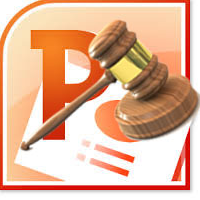Do PowerPoint Presentations Subvert Justice in Jury Cases?
 (graphic: Steve Straehley, AllGov)
(graphic: Steve Straehley, AllGov)
To sway juries into finding a defendant guilty, prosecutors are increasingly using PowerPoint presentations to add dramatic reinforcement to back their arguments in court.
The Marshall Project, a nonpartisan news organization, says appellate courts have reversed at least 10 convictions in just the last two years because district attorneys’ offices went too far in using PowerPoint slides to unfairly influence jurors. There have been additional cases in which appeals court justices have upheld convictions while scolding prosecutors for their use of the ubiquitous Microsoft presentation software.
In some instances, the slides have featured animation and sound effects, including using bull’s-eye images to zero in on a defendant’s photo and declare them “GUILTY” in bright red letters.
In a Washington state case, a state Supreme Court justice challenged the state’s contention that there was nothing wrong with altering a booking photo to include the word “GUILTY” across the defendant’s image. “Under the State’s logic, in a shooting case, there would be nothing improper with the State altering an image of the accused by Photoshopping a gun into his hand,” Justice Tom Chambers wrote.
Prosecutors get advice from organizations such as the National District Attorneys Association, which has even published a 290-page book on how to use visual aids to help convict a defendant.
“It’s the classic ‘A picture is worth a thousand words,’” Eric Broman, a Seattle attorney who focuses on criminal appeals, told the Marshall Project. “Until the courts say where the boundaries are, prosecutors will continue to test the boundaries.”
-Noel Brinkerhoff, Steve Straehley
To Learn More:
PowerPoint Justice (by Ken Armstrong, Marshall Project)
- Top Stories
- Unusual News
- Where is the Money Going?
- Controversies
- U.S. and the World
- Appointments and Resignations
- Latest News
- Trump to Stop Deportations If…
- Trump Denounces World Series
- What If China Invaded the United States?
- Donald Trump Has a Mental Health Problem and It Has a Name
- Trump Goes on Renaming Frenzy






Comments